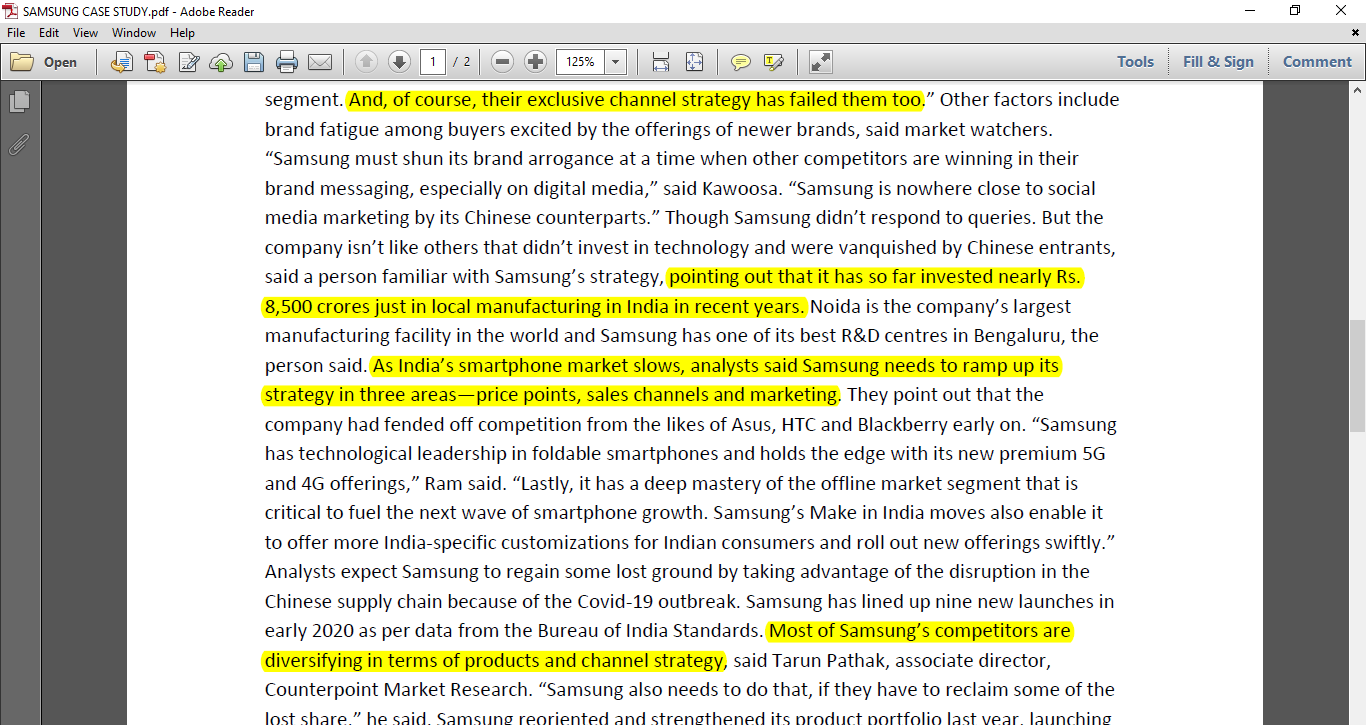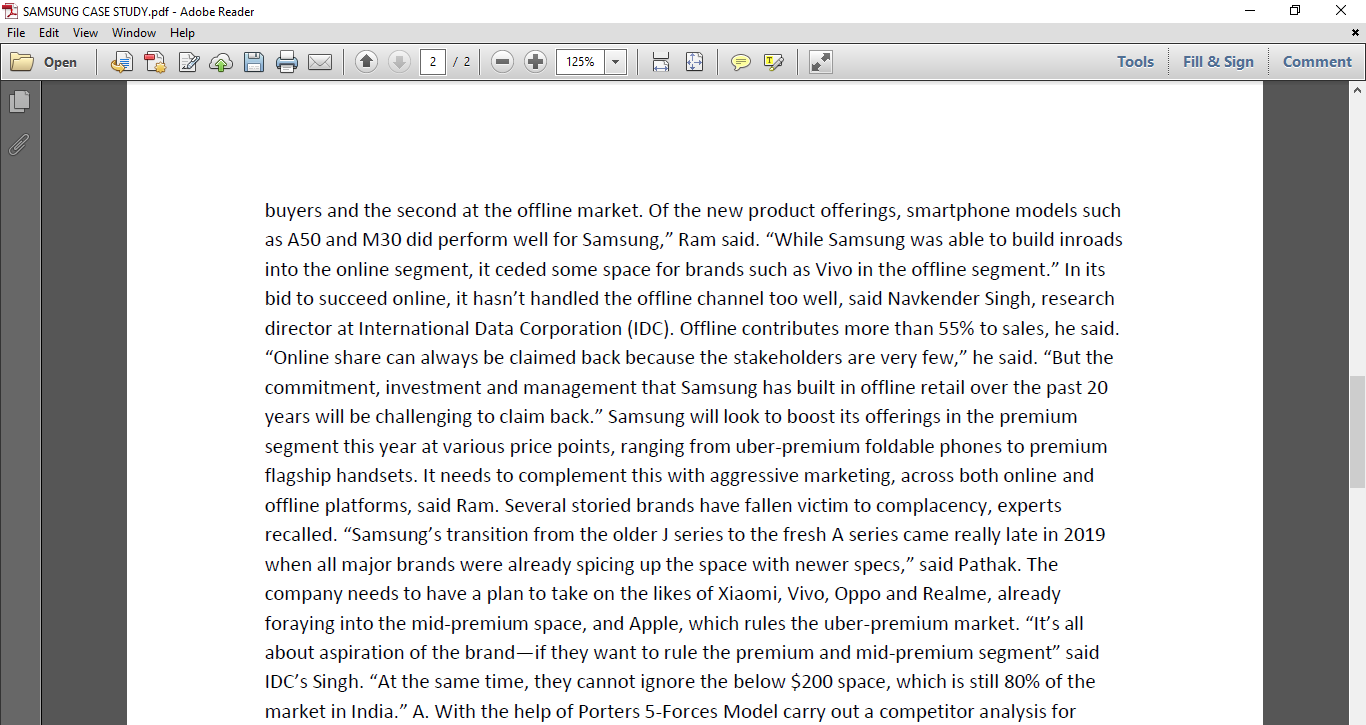SAMSUNG CASE STUDY.pdf - Adobe Reader - X File Edit View Window Help Open + 125% Tools Fill & Sign Comment "Samsung faces tough but 'doable' challenge to rise to top in India handset market") Read the following article and answer the questions given at the end: The first signs of vulnerability came when Samsung lost the smartphone crown to Xiaomi in the September quarter of 2017. In July-September 2019, it was pushed to No. 3 in smartphones by another Chinese player, Vivo. It's been a tough few year for Samsung in the Indian handset market, where it has struggled to keep pace with or beat back competition from Chinese rivals such as Xiaomi, Vivo and Oppo. The first signs of vulnerability came when Samsung lost the smartphone crown to Xiaomi in the September quarter of 2017. In July-September 2019, it was pushed to No. 3 in smartphones by another Chinese player, Vivo. In the same quarter, Samsung also lost its top position in the overall market - smartphones and feature phones - to Xiaomi, after some nine years at the top. Xiaomi though only sells smartphones. Meanwhile, Oppo and Realme are breathing down its neck. According to analysts, Samsung wasn't as nimble as its Chinese rivals and couldn't take advantage of the expansion in the online segment. They however added that Samsung can bounce back, given its investments in technology and local manufacturing, the reputation of its devices and the deep penetration of the offline phone market. It's the only major handset company to manufacture from the ground up in India. "The gaps in Samsung's portfolio have provided opportunities for other smartphone brands, especially new market entrants, to strategize, spot the gaps, and leverage market opportunities," said Prabhu Ram, head of the industry intelligence group at CyberMedia Research (CMR). Mr. Faisal Kawoosa, founder and principal analyst at research firm TechArc, added that Samsung's "brand arrogance has caused it to grossly underestimate the marketing potential of the Chinese comp nies who have now created a niche in almos t every priceSAMSUNG CASE STUDY.pdf - Adobe Reader - X File Edit View Window Help Open + 125% Tools Fill & Sign Comment segment. And, of course, their exclusive channel strategy has failed them too." Other factors include brand fatigue among buyers excited by the offerings of newer brands, said market watchers. "Samsung must shun its brand arrogance at a time when other competitors are winning in their brand messaging, especially on digital media," said Kawoosa. "Samsung is nowhere close to social media marketing by its Chinese counterparts." Though Samsung didn't respond to queries. But the company isn't like others that didn't invest in technology and were vanquished by Chinese entrants, said a person familiar with Samsung's strategy, pointing out that it has so far invested nearly Rs. 8,500 crores just in local manufacturing in India in recent years. Noida is the company's largest manufacturing facility in the world and Samsung has one of its best R&D centres in Bengaluru, the person said. As India's smartphone market slows, analysts said Samsung needs to ramp up its strategy in three areas-price points, sales channels and marketing. They point out that the company had fended off competition from the likes of Asus, HTC and Blackberry early on. "Samsung has technological leadership in foldable smartphones and holds the edge with its new premium 5G and 4G offerings," Ram said. "Lastly, it has a deep mastery of the offline market segment that is critical to fuel the next wave of smartphone growth. Samsung's Make in India moves also enable it to offer more India-specific customizations for Indian consumers and roll out new offerings swiftly." Analysts expect Samsung to regain some lost ground by taking advantage of the disruption in the Chinese supply chain because of the Covid-19 outbreak. Samsung has lined up nine new launches in early 2020 as per data from the Bureau of India Standards. Most of Samsung's competitors are diversifying in terms of products and channel strategy, said Tarun Pathak, associate director, Counterpoint Market Research. "Samsung also needs to do that, if they have to reclaim some of the lost share " he said, Samsung reoriented and strengthened its product ortfolio last year, launchingE SAMSUNG CASESTUDYpdf-Adobe Reader 7 X File Edit View Window Help x 'Open l@@@@--|$ 2 12|@@125% . |'' E3||g ToolngiIISISign Comment buyers and the second at the offline market. 0f the new product offerings, smartphone models such as A50 and M30 did perform well for Samsung,\" Ram said. "While Samsung was able to build inroads into the online segment, it ceded some space for brands such as Vivo in the offline segment.\" In its bid to succeed online, it hasn't handled the offline channel too well, said Navkender Singh, research director at International Data Corporation (IDC). Offline contributes more than 55% to sales, he said. "Online share can always be claimed back because the stakeholders are very few,\" he said. "But the commitment, investment and management that Samsung has built in offline retail over the past 20 years will be challenging to claim back." Samsung will look to boost its offerings in the premium segment this year at various price points, ranging from uberrpremium foldable phones to premium flagship handsets. It needs to complement this with aggressive marketing, across both online and offline platforms, said Ram. Several storied brands have fallen victim to complacency, experts recalled. \"Samsung's transition from the older] series to the fresh A series came really late in 2019 when all major brands were already spicing up the space with newer specs,\" said Pathak. The company needs to have a plan to take on the likes of Xiaomi, Vivo, Oppo and Realme, already foraying into the midpremium space, and Apple, which rules the uberpremium market. "It's all about aspiration of the brandiif they want to rule the premium and midpremium segment" said IDC's Singh. \"At the same time, they cannot ignore the below $200 space, which is still 80% of the market in India.\" A. With the help of Porters 5Forces Model carry out a competitor analysis for A









